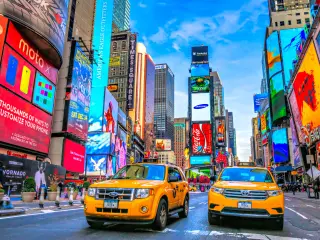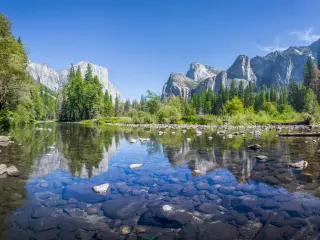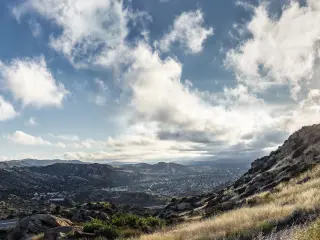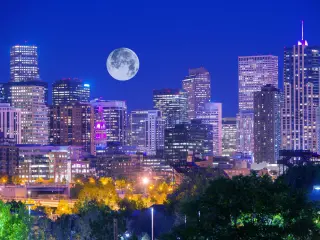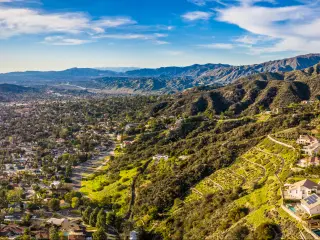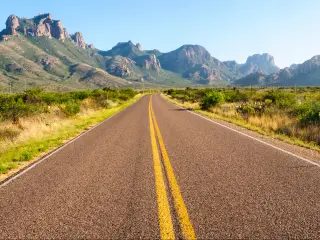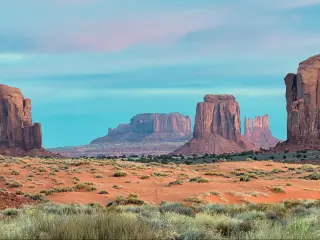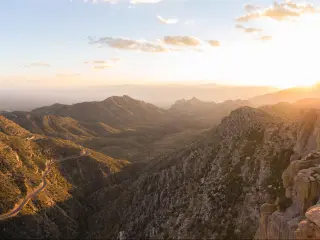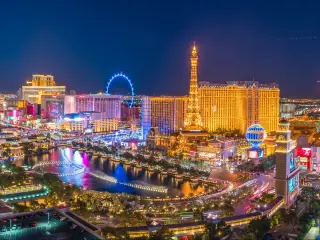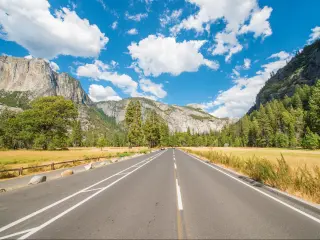30 Best National Parks Near Las Vegas
Sitting in the middle of the Mojave Desert and within driving distance of everything from snow-covered mountain peaks, lush forests and stunning canyons, Las Vegas is near to some of the best National Parks in the country.
If you want to visit more than just National Parks or want more detailed route information, check out our list of the best road trips from Las Vegas.
For those who want to see the Red Rocks of Sedona, redwood forests of the Sierra Nevada or the Grand Canyon, we've put together the list below.
National Parks Near Las Vegas
- Death Valley National Park, California
- Zion National Park, Utah
- Grand Canyon National Park, Arizona
- Arches National Park, Utah
- Yosemite National Park, California
- Yellowstone National Park, Wyoming
- Monument Valley, Arizona - Utah border
Here is the full list of the 30 best National Parks near Las Vegas.
If that's not enough nature for you to explore, below you'll also find a list of the best National Monuments, State Parks, National Conservation Areas and Preserves near Las Vegas.
1. Death Valley National Park, California
1 hour 55 minutes from Las Vegas (125 miles)

The nearest national park to Las Vegas is the iconic Death Valley National Park in California, located only a short two-hour drive from Sin City.
To get there, take US Route 95 going north, and then either Route 373 or 374 into Death Valley depending on which part of the national park you're heading to.
Holding records for the lowest, driest, and hottest National Park in the US, this below-sea-level basin is one of the unique places to visit.
Known famously as the land of extremes, it is home to Badwater Basin, located 282 feet below sea level, making it the lowest point in North America, and Telescope Peak, which stands at 11,048 feet above sea level.
Most people don't realise that Death Valley is home to a huge variety of different landscapes ranging from rocky desert to mountains to dried out lakes and even sand dunes.
The park is famous for Artist's Drive, a 9-mile route situated on the slope of the Black Mountains and boasts scenic views of the vibrant geological rock formations. Another attraction that you can't miss out on is the Devil's Golf Course, an eerie-looking golf course situated on the unique salt flats of the national park.
Since the Death Valley National Park operates on extremes, it can get hot beyond belief - the hottest ever temperature reading of 134.1 °F was recorded here in 1913, so make sure you bring plenty of water.
If you happen to visit in the spring, you might be surprised to find that the rains bring beautiful wildflowers to bloom in the park.
The winter is the most pleasant time to visit as the weather is still warm and perfect for hiking and exploring the sites.
Bonus: Death Valley National Park is an International Dark Sky Park, so if you park up or camp at night, you'll get a chance to witness a starry night sky like no other!
2. Zion National Park, Utah
2 hours 40 minutes from Las Vegas (160 miles)

One of the most visited national parks in the country, and our personal favorite, is less than 3 hours' drive from Las Vegas!
Zion National Park, situated in southwest Utah, is known for its spectacular red canyons covered in forest.
Getting to Zion National Park from Las Vegas is very easy - take the I-15 heading north towards Salt Lake City, and shortly after entering Utah, follow Route 9 east to the park!
Spread across 148,000 acres, Zion is an unusual National Park in mixing a dry desert landscape and canyons with trees, rivers and general greenery.
The Narrows are one the most-coveted spots in the park as the area is majestic and has some of the most impressive hikes in the entire National Park system.
For those wanting to get in the water, Virgin River flows through the park, and it's great for swimming or kayaking (with a permit that you can obtain for free at the park's visitor center).
The park is also home to the Emerald Pools, which are a group of natural water pools complete with striking waterfalls and a hanging garden.
You can go backpacking, camp in one of the three picturesque park campgrounds and explore the national park on horseback - the list of ways to explore is endless.
Zion National Park is an all-weather park but is generally at its best in the autumn when you'll get a chance to hike through the lovely fall foliage, witness breathtaking sunsets, and gorge on well-prepared seafood at Red Rock Grill (located at Zion Lodge).
If you'd like to hike up to Angels Landing, you will need a permit and will need to make a reservation. Check the Zion National Park's website for more details.
READ MORE - Road Trip From Las Vegas To Zion National Park
3. Joshua Tree National Park, California
3 hours 5 minutes from Las Vegas (190 miles)
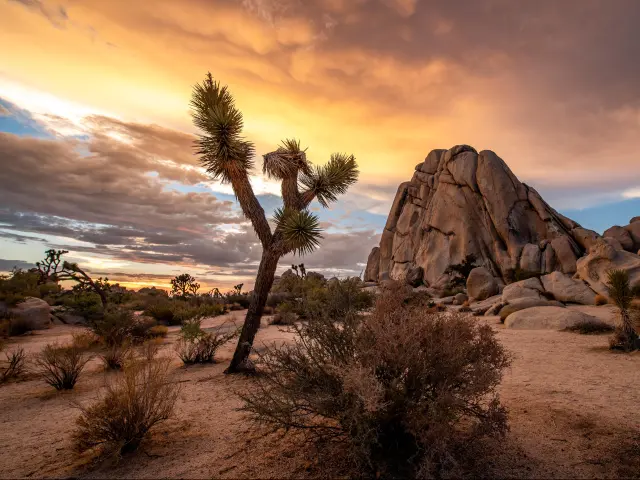
Home to unique geological features, fascinating wildlife and plants that have adapted to the distinctive climate, and a vibrant past, the Joshua Tree National Park in Southern California is just three hours from Las Vegas.
The fastest route to Joshua Tree National Park from Las Vegas is to follow I-15 south and then cut right across the Mojave National Preserve to Amboy and approaching the park from the north past the Cleghorn Lakes and Sheephole Valley Wilderness Areas.
Named after the memorable, twisted Joshua Trees that are popular in the region, the area marks the meeting point of two distinct desert ecosystems - the Colorado Desert and the Mojave Desert.
Keys View, the highest point in the park, offers stellar views stretching the breadth of the park and nearby regions like the Coachella Valley (the iconic spot where the Coachella music festival takes place annually), Palm Springs (lavish California resort city), and beyond.
Other places to explore in the region are the Black Rock Canyon, which is home to that famous Joshua Tree forest, Echo Cove, where you'll find up to 8,000 known formations on which you can go rock climbing, and Cholla Cactus Garden, where you'll get to observe dangerous but majestic cacti in their natural habitat.
Whether you're a hiking enthusiast, want to camp under the stars or see some of the unique animals that live here ranging from white-tailed antelopes to coyotes, Joshua Tree is a perfect getaway from the hustle and bustle of Las Vegas.
Bonus: Try and plan your road trip so that you can catch the awe-inspiring sunset from the boulders on Arch Rock Trail!
READ MORE - Road Trip From Las Vegas To Joshua Tree National Park
4. Bryce Canyon National Park, Utah
4 hours from Las Vegas (260 miles)
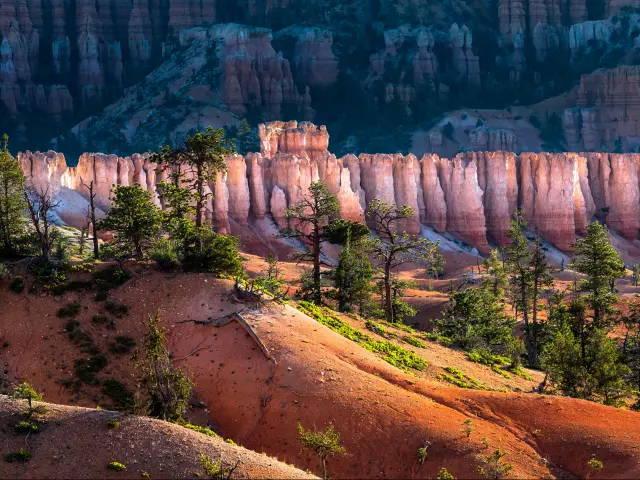
Known for having the most extensive collection of red-hued hoodoos (a natural column of rock formations) globally, Bryce Canyon National Park is real gem!
Located a four-hour drive from Vegas, you can reach Bryce Canyon by following I-15 north and then following Route 20 East after passing Parowan and then US Route 89 south to the park.
The natural rock formations are mainly composed of elements like sandstone, limestone, magnesium, iron, and other elements leading to unique colorations and distinctive shapes.
The Rim Trail hiking path overlooks the expansive hoodoo-filled amphitheater. The park is also home to several spots like Sunrise Point, Inspiration Point, and Bryce Point, and each boasts sweeping views of the Canyon and beyond.
This is one of the smaller national parks on the list, but it's definitely worth a day trip or an overnight stay with some very spectacular hiking opportunities.
Bryce Canyon National Park is set at a very high altitude, so the weather in the higher elevations can be pretty cold and unpredictable, so make sure you bring extra layers.
While the climate can change quickly, you can visit at any time of year; the winter is particularly fascinating as you'll get to see the red rocks clad in snow and even get a chance to go cross-country skiing in the area!
5. Grand Canyon National Park, Arizona
4 hours 20 minutes from Las Vegas (275 miles)

Sitting near the border of Arizona and Utah is the wonder of the natural world and probably the most famous national park near Las Vegas - the Grand Canyon National Park.
Situated 275 miles from Vegas, if you're going to pick one national park to visit, I am guessing it might be this one!
The fastest and most scenic route to the Grand Canyon is by following US Route 93 from Boulder towards Phoenix, and then following the I-40 from Kingman heading east.
Just before you get to Flagstaff, Route 64 will take you all the way to Grand Canyon Village and the South Rim.
You can also reach the North Rim of the park by taking the I-15 and then crossing south from Utah into Arizona - the two routes are almost identical in terms of the time it'll take to drive.
Heading to the South Rim offers the option of seeing the red rocks of Sedona along the way, but going to the North Rim means you can also visit Vermillion Cliffs and Grand Staircase-Escalante National Monuments.
Grand Canyon is one of the oldest national parks in the United States and the views will tell you why.
Interestingly, at one point in the 1800s, a team of explorers was sent in to assess the region's profitability and concluded that the collection of red rocks was beautiful but relatively valueless.
But following a visit by President Theodore Roosevelt in 1903, tourism to the park began rising rapidly and since then has been one of the most popular destinations in the country.
The park houses several scenic overlooks which boast panoramic views of the canyons and beyond, the glistening Colorado River that flows through the canyonland (you can go rafting or paddleboarding in the river), and much more.
There are plenty of hikes in the park, ranging from beginner-level walking trails to challenging and professional endurance hikes.
You can also spot wildlife like Bighorn Sheep, Mountain Likes, Elk, Grand Canyon Rattlesnakes (they are pink-colored fascinating creatures), Mules, and more.
The area was also designated as a Globally Important Bird Area in 2014, and several rare species like the California Condor, Yuma Clapper Rail, and more call it home.
The best time to visit is the early summer (April to June), when you'll be able to explore all the regions (as the North Rim closes in the winter), stay at the campgrounds or one of the park's iconic lodges (especially the El Tovar Lodge), and soak in the shadow of the majestic canyons.
READ MORE - Road Trip From Las Vegas To Grand Canyon
6. Great Basin National Park, Nevada
4 hours 50 minutes from Las Vegas (300 miles)
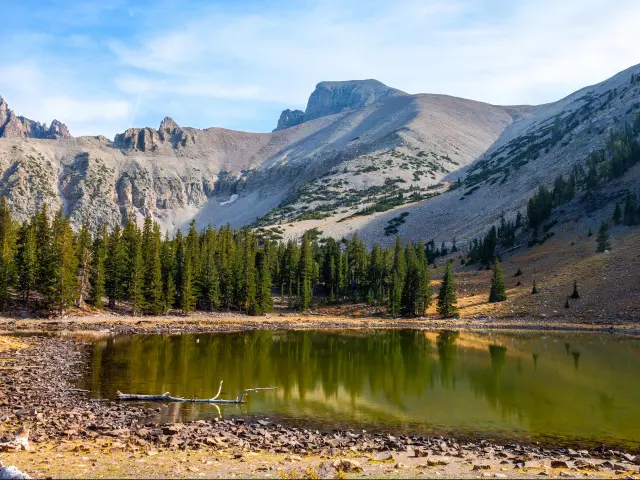
If you're searching for a national park without long queues and zero empty parking lots, the Great Basin National Park, located a five-hour drive from Vegas, is a great choice.
To get to Great Basin National Park from Las Vegas, you'll need to follow the I-15 and after getting out of the city, take US Route 93 north, which will take you almost the entire way there!
A region encompassing the vast diversity of the larger Great Basin region, here you'll find broad low-hanging valleys juxtaposed by towering peaks, arid desert landscapes, eerie caves, and so much more.
It's a great place to have a quiet, introspective time with nature, as you'll explore places like Wheeler Peak, which is the second-highest peak in the state, standing tall at 13,065 feet, and the Lehman Caves, which have a rich ecology and geological history leading to their odd and majestic appearance.
The park is set in an extremely remote part of Nevada and is one of the least visited parks in the entire National Park System, making it one of the best spots for stargazing if you choose to stay at one of the spectacular, high-altitude campgrounds in the park.
You're also going to have the hiking routes in the park all to yourself although some are reserved for trained and professional hikers, like the Wheeler Peak Trail and Stella Lake Trail.
The Baker Creek Trail will lead you to one of the park's delightful lakes, where you can go fishing for Rainbow Trout!
7. Capitol Reef National Park, Utah
5 hours 10 minutes from Las Vegas (325 miles)
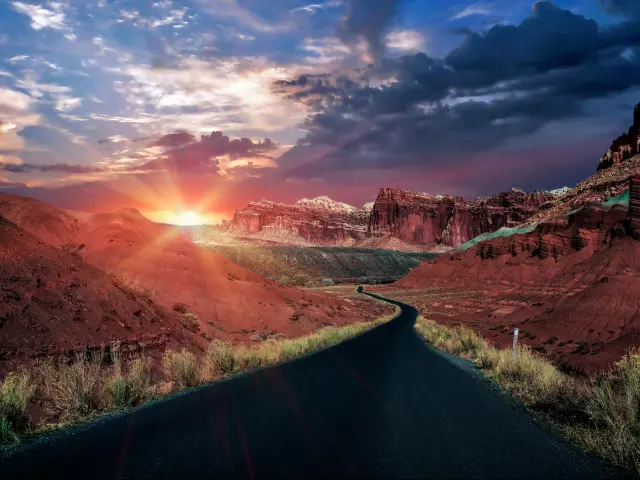
Located 5 hours from Las Vegas is the stunning and unique Capitol Reef National Park.
The name for the place is symbolic of its two distinctive landscapes; the word “capitol” is used to refer to the pristine white sandstone peaks in the park, while the word “reef” comes from the rugged rock that appears in the national park's land which is similar in appearance to the coral reefs frequently seen in an ocean.
The route there once again follows the I-15 and Route 20, as if you were headed to Bryce Canyon, but then follows Routes 62 and 24 deeper into Utah's wilderness,
The land and its colorful ridges tell the tales of its past inhabitants, from Paleo Indians to Mormon Settlers, Navajos, and early European tourists. Known widely for being home to the Waterpocket Fold, which is a monocline (a geologic wrinkle on the earth), you'll get a chance to learn about the ecological changes that lead to such wonders.
There are a great many ways to discover the wonders of Capitol Reef - you can try camping, hiking, horseback riding, orchard tours (the park is home to ancient orchards, including trees like pear, peach, apple, mulberry, etc.), or canyoneering.
Some of these activities require permits, so be sure to get the paperwork sorted before you go.
Bonus: As a vast national park located in a remote area, Capitol Reef is one of the top International Dark Sky Parks, perfect for a night of stargazing and spotting constellations.
8. Channel Islands National Park, California
5 hours 15 minutes from Las Vegas (320 miles)
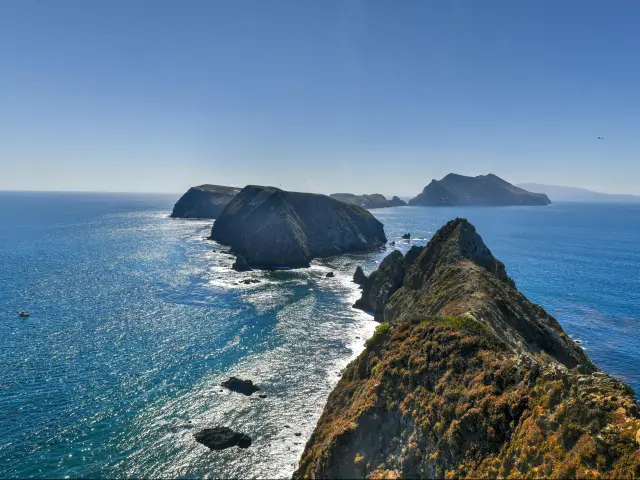
A national park like no other, the Chanel Islands National Park comprises five different islands located off the coast of California. A 5 hour-long road trip from Vegas to Ventura from where you'll have to take a boat to the island you're hoping to visit.
Getting to Ventura from Las Vegas is straightforward! The I-15 will take you all the way to Barstow and from there, Routes 58, 14 and 126 will take you through Santa Clarita all the way to the port.
You can go through Pasadena and other parts of Los Angeles en route, but it'll naturally add time to your journey so you might want to take a different route back to get the most out of your trip.
The five different islands of the Channel Islands National Park have something different to offer.
Santa Cruz Island is known for its sea caves, one of which is an iconic quarter-mile painted cave with colorful walls where you can go kayaking (and even catch a glimpse of a sea lion).
Anacapa Island is known for its old-timey 1932 lighthouse and Inspiration Point, which boasts stunning vistas of the sea and land beyond.
The smallest of the Channel Islands in Santa Barbara Island, which besides having a vibrant history, is home to elephant seals, California harbor seals, and more. San Miguel is a 9,500-acre large island with unique wildlife, diverse cultural resources, and more.
Santa Rosa Island is home to Torrey pines, one of the rarest pine species in the world.
Each of the islands has different activities to indulge in, vibrant history and culture to immerse yourself in, and panoramic views of the beautiful azure sea, but remember there is virtually no infrastructure on the islands so don't expect hotels or shops when you get there!
9. Petrified Forest National Park, Arizona
5 hours 35 minutes from Las Vegas (370 miles)
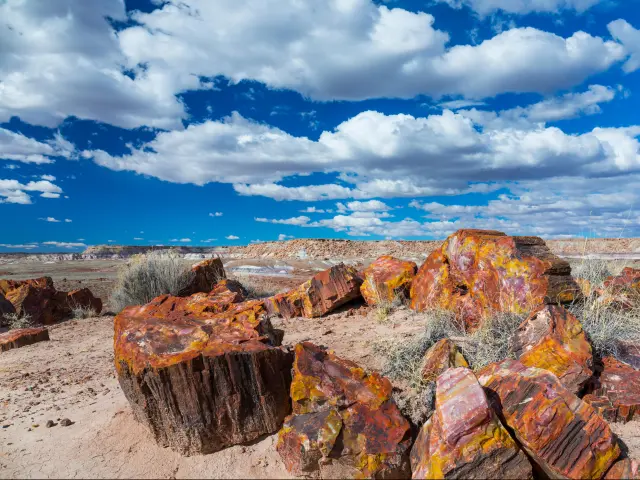
Home to the Rainbow Forest, a region filled with colorful petrified wood, ancient petroglyphs as signs of past inhabitants, and historically-rich structures, the Petrified Forest National Park is located in northern Arizona, a five-and-a-half-hour drive from Las Vegas.
Route 93 will take you from Las Vegas to Kingman and from there it is a long stretch east along the I-40, past Flagstaff and almost all the way to the New Mexico border.
Home to several natural marvels like the colorful stripes in the Painted Desert, petrified wood, paleontology exhibits, ancient village ruins, etc. It is one of the world's largest concentrations of petrified wood which you'll observe as you tour the region.
The park's geology goes back over a million years and it was first settled by humans some 13,000 years ago.
Eventually, the Puebloan people began to inhabit the region, and you'll be able to catch a glimpse into their lives as you tour the abandoned buildings and petroglyphs spread across the national park.
As with many parks, horseback riding, hiking (the trails in the Petrified Forest are ideal for those looking for a short off-trail excursion), driving the park's routes to reach scenic overlooks and backpacking are all on the menu.
So if you're looking for a getaway that combines nature, geology and the history of its people dating back thousands of years, Petrified Forest is the national park to pick.
10. Sequoia National Park, California
5 hours 55 minutes from Las Vegas (380 miles)

Located in the Sierra Nevada mountains in southern California, the Sequoia National Park is a 6-hour drive from the resort city of Vegas and perfect for a trip at any time of year.
You'll need to drive around Sierra Nevada to get into Sequoia National Park because the routes into the park are from the west, so you'll need to take the I-15 and Route 58 to Bakersfield before heading north along Route 65 to get there.
The park is known for its massive sequoia trees, bubbling river streams, underground caves, and a diversity of mountain landscapes. One of the most famous sights is the General Sherman Tree (275 feet tall), the largest (but not the tallest) tree in the world, weighing four and a half million pounds.
One of the top ways to explore the park is via the region's scenic drives, which are ideal, especially since you'll be taking a road trip to the national park! The Sequoia National Park is located within proximity of the Kings Canyon National Park (connected via The General's Highway), so you can easily tour both parks on one trip.
The must-do things in the national park are to walk through the forest trails amidst the towering trees, observe the interactive exhibits at the Giant Forest Museum, and tour iconic attractions like Crystal Cave and Moro Rock (which boasts stunning views of the forested region and beyond).
The park is famous for hosting an annual Dark Sky Festival that involves solar observations, photography workshops, constellation tours, and more, so check out the dates for that in case that's something you'd enjoy!
11. Saguaro National Park, Arizona
6 hours 15 minutes from Las Vegas (405 miles)
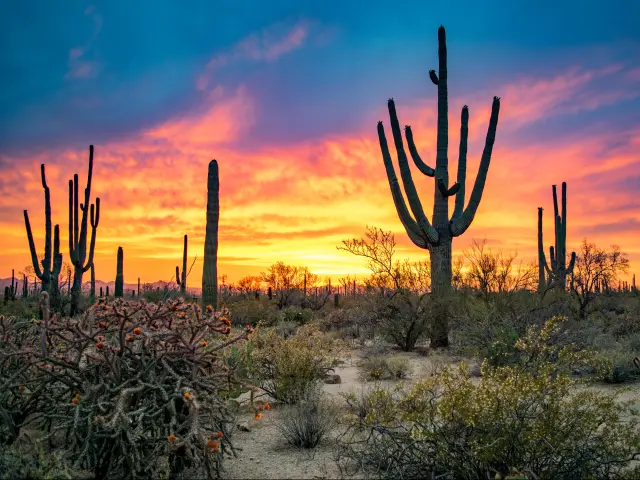
Named for the giant Saguaro Cactus that populates the region, the Saguaro National Park is located 400 miles away from Las Vegas in southern Arizona.
Saguaro National Park is just outside Tucson in Arizona so follow US Routes 93 and 60 to Phoenix and then the I-10 all the way to the park.
The park has two different parts located on opposite sides of Tucson, with different natural features to explore.
The eastern section is known for its scenic road called Cactus Forest Drive, which boasts stunning overlooks of the region, while the western section is known for its trails and petroglyphs of ancient habitats.
The infamous Saguaro Cactus, indigenous primarily to this region, is a large tree-like cactus species that can live up to 250 years! If you happen the visit between May and July, you might spot the gorgeous white flowers on the cactus.
Though extremely rare and hard to spot, you may also spot some animals like ground squirrels, ring-tailed cats, gray foxes, and more that inhabit the region, along with unique birds like Whiskered Screech Owls and Vermillion Flycatchers.
The arid region is also home to several reptiles, so watch out for the Gila monster and diamond-backed rattlesnake.
12. Arches National Park, Utah
6 hours 45 minutes from Las Vegas (450 miles)
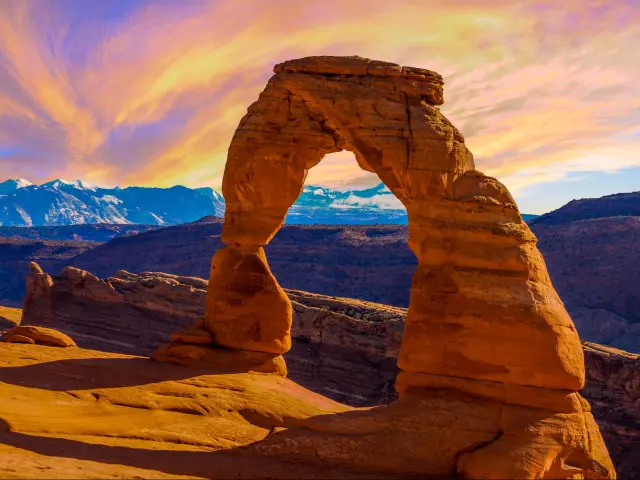
Famous for being home to over 2,000 natural red sandstone arches, the Arches National Park, located north of Moab in Utah, is one of the most iconic national parks in the region!
It is located 450 miles from Las Vegas and is one of the two big national parks near Moab, the other being Canyonlands.
The route might take you a little while, but it's very easy - Take the I-15 north and a few hours later follow the I-70 east. Eventually you'll see signs for US Route 191 heading south to Moab.
The arches in the Arches National Park were created over millions of years through sand erosion and are truly breathtaking, especially with the backdrop of a colorful sunset.
The park is located 4,000 feet above sea level leading to frequent temperature fluctuations, so it's vital to be prepared with all the essentials in case the weather takes a turn.
The park is relatively small and known for its hikes and guided tours, especially the Devils Garden Trail and a ranger-led hike that travels through the Fiery Furnace (reservations are mandatory).
Other tours offered include the Arches 4x4 adventure, Private Petroglyph Tour or a scenic flight over the Arches.
One of the most common past times is trying to take the perfect shot of the moon, sun or anything else showing directly through one of the stunning arches.
The darkness in the region allows Arches to be an Official International Dark Sky Park, ideal for some spectacular star gazing, especially on moonless nights.
Located close to Canyonlands National Park, Glen Canyon Recreational Area, and Capitol Reef National Park, you could plan a mega Utah canyon road trip to visit all these spectacular landscapes!
You might need to make a reservation for a timed-entry permit while visiting Arches National Park. Please check the national park's website for up-to-date information.
READ MORE - Road Trip From Las Vegas To Arches National Park
13. Kings Canyon National Park, California
6 hours 50 minutes from Las Vegas (415 miles)

Home to several hiking trails, scenic overlooks, bubbling waterfalls, and more, the Kings Canyon National Park is located in California's Sierra Nevada Mountains, beside the Sequoia National Park.
The 7-hour drive from Vegas will take you around the southern edge of the Sierra Nevada through Bakersfield before heading north along the mountains to get to Kings Canyon.
Located at the northwest boundary of the park is the Sierra National Forest, which is home to famous forest destinations like the John Muir wilderness, Monarch Lakes, and more.
Not quite as big as its neighbor in the Sequoia National Park, the General Grant Tree in Grant Grove stands 267 feet tall and is still very impressive.
There are several hiking routes in the park, each varying in complexity and altitude and you can do a whole lot more including fishing, rock climbing, horseback riding, overnight backpacking, and winter adventure sports if you're coming for the snow.
Though not one of the most visited parks, its beautiful sweeping landscapes, and fewer crowds make it a fine national park to visit, especially if you're planning to combine a visit to Kings Canyon and Sequoia National Park for the perfect getaway!
14. Canyonlands National Park, Utah
7 hours from Las Vegas (470 miles)

Known for its distinctive orange-hued desert landscape, the Canyonlands National Park is located in eastern Utah, a 7-hour drive from Las Vegas.
The route from Las Vegas to Canyonlands is almost identical to Arches National Park as the two are both near Moab and you'll have to follow the I-15 and I-70 for the majority of the way before taking US Route 191 south for the final stretch.
Divided by its rivers into four districts, Canyonlands is split into The Needles, Island in the Sky, The Maze, and the Rivers.
All the usual ways to explore the national park including fantastic hiking routes are available and it shares some of the unique rock formations with the nearby Arches National Park.
You'll find the famous Mesa Arch (a very popular spot for sunrise photos), the Green River Overlook, and Newspaper Rock (which has one of the largest petroglyphs collections in the US).
You can also choose to tour Horseshoe Canyon, which has some of the most significant rock art in the country, though the hike to get there is pretty challenging.
Aside from hiking and camping, you can try boating in the Colorado River, or relax and stargaze once the sun goes down.
Be sure to spend a couple of minutes at Grand View Point at sunset, if you can, and soak in the astonishing views of the pink and orange sky above the red-hued jagged canyons - you can say thank you later!
15. Yosemite National Park, California
7 hours from Las Vegas (400 miles)
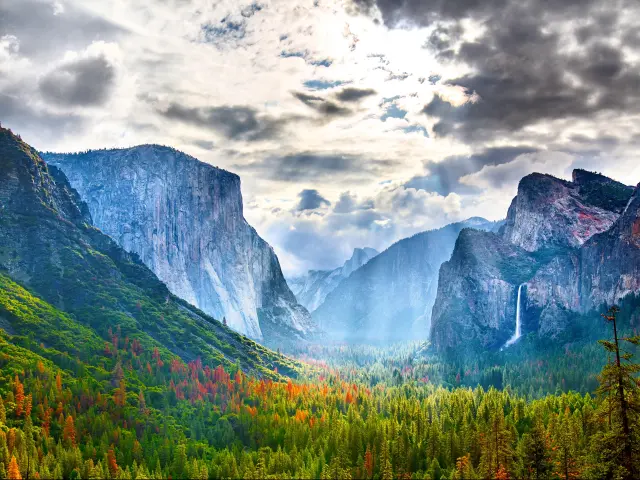
Known across the world for its natural beauty, towering Sequoia trees, spectacular waterfalls, and other gems of nature, Yosemite National Park, located in the Sierra Nevada Mountains in California, is one of the most popular national parks in the country.
Over the summer months, you can take US Routes 95 and 6 to Mono Lake and then cross the mountains along Tioga Pass.
In the winter (which includes a fair bit of fall and spring), the Tioga Pass is closed, so you have to follow the long way around the south of Sierra Nevada through Bakersfield adding 60 miles and half an hour to your drive time.
There is a reason why Yosemite is popular - there is a lot to see from the beautiful Yosemite Valley bordered by rugged high cliffs to the breathtaking waterfalls that make for stunning photo backdrops and the massive Sequoia trees.
Even after touring the park a couple of times, you'll continue to find something new to explore.
Top attractions to tick off on your itinerary, especially if you're visiting the park for the first time, are Glacier Point, which boasts scenic overlooks of the valley, Bridalveil Fall, a 620 feet tall waterfall of your dreams, and Tunnel View for iconic vistas of the valley, particularly El Capitan and Half Dome.
The park is home to an estimated 300 to 500 black bears that roam the region, and if you're hoping to spot one, the NPS regularly updates information about the best bear spotting areas.
The region is also a hiker's haven, with the park having some 60 trails with over 750 miles of routes which are a brilliant way to explore the area's beautiful landscapes.
Though it's open 24 hours, 365 days, the ideal time to visit the park is in late spring as you'll be able to witness all the waterfalls without the roaring summer crowds.
Early fall can also a great time to make the trip, as you'll get to see the iconic fall leaves of Yosemite, but it really is worth the trip year-round.
READ MORE - Road Trip From Las Vegas To Yosemite National Park
16. Pinnacles National Park, California
7 hours 30 minutes from Las Vegas (455 miles)
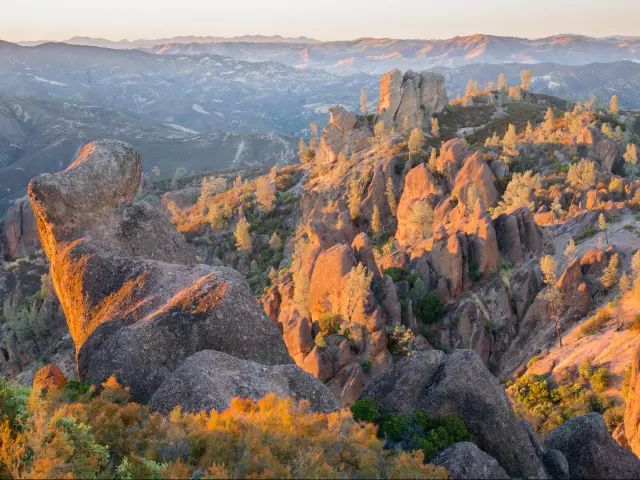
Located in Salinas Valley in Central California is the Pinnacles National Park, is the smallest and youngest national park in California covering 26,600 acres.
Most of the route follows long stretches along major highways - you'll follow the I-15, Route 58 and the I-5 before taking Exit 325 to follow State Routes 198 and 25 through the mountains to Pinnacles, near Soledad.
The rock formations in this park were formed as a result of a now dormant volcano on the San Andreas Fault, and you can explore the jagged cliffs along one of the many hiking trails in the region (the High Peaks Trail to Bear Gulch Loop is one of the best).
You'll also discover talus caves resulting from the clash of narrow canyons and boulders.
It's also an excellent place for bird watching as the park is home to the endangered California Condor. With a mere estimated 300 condors globally, spotting this majestic bird won't be easy but very rewarding if you do see one.
Since it is located in a region known for its extreme summers, visiting the Pinnacles National Park may be better in the spring and fall.
Whichever time you do end up going, the temperatures can pick up and drop pretty fast, so pack a few different clothing options before you leave Las Vegas.
17. Mesa Verde National Park, Colorado
8 hours 40 minutes from Las Vegas (520 miles)
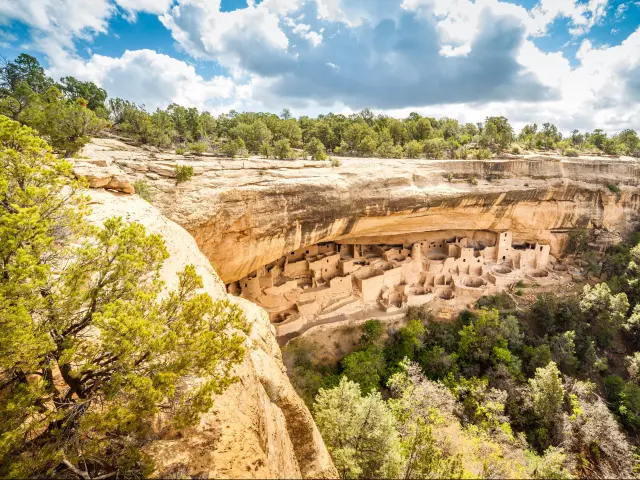
Located in southwest Colorado, Mesa Verde National Park is a national treasure that preserves the history of the Puebloan dwellings and honors the region's Native American past.
The national park is an eight-and-a-half-hour drive from Las Vegas and is the perfect place for a break from the hustle and bustle of the city, especially if you're a history buff.
You can take your pick of driving around the north or south side of the Grand Canyon on the way from Las Vegas to Mesa Verde as it takes about the same amount of time.
It also means you can go and come back via different routes to make the road trip more interesting.
The two routes converge as you enter Navajo Nation territory in northeastern Arizona and you have to cross past Monument Valley into Colorado to get to Mesa Verde.
A World Heritage Site, this region was home to Ancestral Pueblo people for over 700 years, and the park has preserved the dwellings of up to 26 tribes to highlight their vibrant cultural heritage and celebrate their lives.
The most famous part of the park is the Cliff Palace, the largest cliff dwelling in all of North America.
You'll also discover places like the Mesa Top Loop Road, where you can go on a drive with a view, Sun Point Overlook to catch the beautiful sunrise over the cliffs, and Chapin Mesa Archeological Museum, where you'll find interactive exhibits about the lives of the Native American inhabitants and learn about them.
Mesa Verde National Park is open year-round, and it really is a good trip any month of the year.
The weather during the winter months isn't too harsh, but snowstorms can occur. Visiting between June to September is perfect - the weather is not too hot and the evenings are very pleasant.
18. Black Canyon of the Gunnison National Park, Colorado
9 hours from Las Vegas (580 miles)
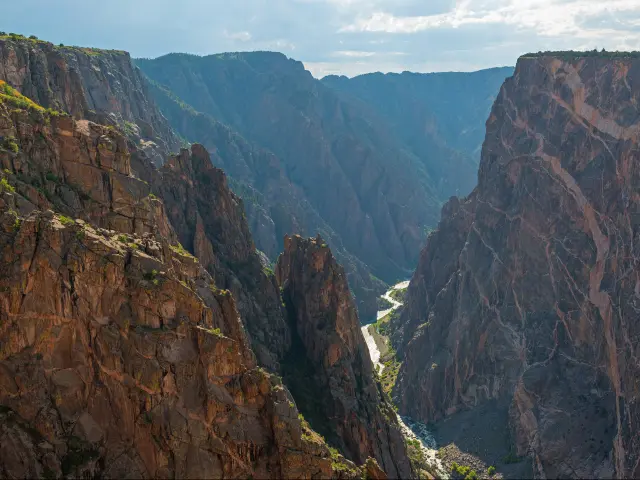
Formed as a result of years of two million years of weathering and ecological changes, the Black Canyon of the Gunnison National Park is home to one-of-a kind iconic steep canyons and jagged cliffs contrasted by the ethereal Gunnison River in Western Colorado.
The 9-hour drive from Las Vegas to the Rockies follows the I-15 and I-70 all the way across Utah and a short drive south along US Route 50 south from Grand Junction.
A top tip for those who love a scenic road is to follow the I-70 a little further towards Denver and then take the Grand Mesa Scenic Byway instead for a great twisty mountain road with awesome views.
Open year-round, each time of year offers a different experience of touring the cliffs of this national park.
Though it isn't as frequently visited or talked about as some other Colorado National Parks, you can soak in the phenomenal views of the ashen canyons, and discover some great hiking trails.
The park also has not one, but two scenic driving roads - the main one being South Rim Road Drive and the more secluded North Rim Road Drive.
The foothills of the Rocky Mountains are perfect for watching the autumn leaves or spotting constellations as you camp in this International Dark Sky Park.
19. Lassen Volcanic National Park, California
9 hours 30 minutes from Las Vegas (565 miles)

Lassen Volcanic National Park, located in northern California, is a geological marvel and a must visit despite the almost 10-hour drive to get there from Las Vegas.
Although the route covers over 500 miles, it's a relatively easy drive. Follow US Route 95 past Death Valley National Park across Nevada all the way to Reno.
From Reno, cross into California along US-395 to Susanville and then follow Route 36 into Lassen National Forest.
Lassen Volcanic National Park was formed into the unique landscape it is today due to the explosion of Lassen Peak, one of the 300 volcanoes that make up the Ring of Fire which encircles the Pacific Ocean.
Now dormant, Lassen Peak stands 10,457-feet tall and had its last eruption in 1914, which lasted 3 years. The national park is home to other smaller volcanos as well.
The mix of ash and rich soils means you'll find wildflower-filled meadows, pristine alpine lakes (which came about due to molten lava cooling and creating ridges in the ground) and bubbling hot springs.
You can explore the park whichever way you want - hiking, backpacking, biking, swimming, and boating are all options.
The park is also known for its stargazing excursions like hiking the Cinder Cone trail on a full moon night, attending a Starry Night ranger-led program and celebrating the annual Dark Sky Festival.
Though located a long drive away from Vegas, the sheer geological wonders and beauty of the Lassen Volcanic National Park make it an unforgettable visit!
20. Grand Teton National Park, Wyoming
11 hours from Las Vegas (675 miles)
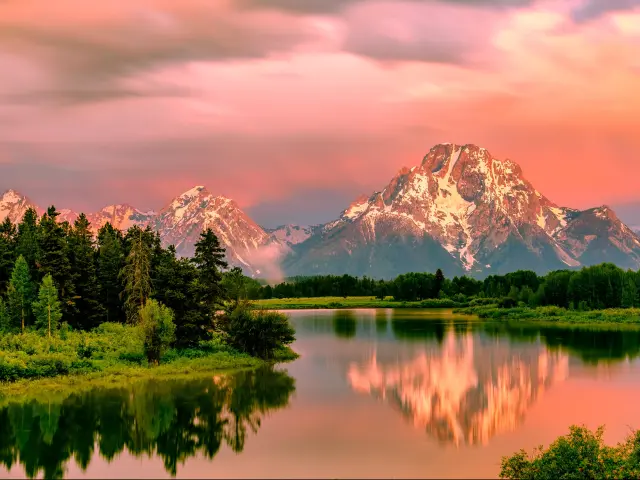
Located in northwestern Wyoming, the Grand Teton National Park is home to some of the most beautiful landscapes in the country, which is why it's one of the most visited national parks in the US!
Often overlooked in favor of Yellowstone further up the road, Grand Teton National Park is definitely worth your attention.
The 11-hour drive could be done in a day driving the I-15 from Las Vegas towards Salt Lake City and then US-89 and US-191 from Alpine to Jackson.
With beautiful clear lakes, rugged snow-capped mountains, and beautiful blooming meadows, most of the overlooks in Grand Teton National Park look like they're straight out of a movie.
You'll get to explore the 4,000-ft Grand Teton peak, the tallest of the Teton mountain range, and the infamous Jackson Hole valley.
It's a favorite amongst mountaineers and backpackers, especially in the summer, because of its breathtaking vistas accompanied by an array of different, exciting hikes to conquer.
The park is also a nature preserve making it the ideal place to spot some Black Bears, Elk, Grizzly Bears, Bison, Antelope, Mountain Lions, and other wildlife that call the park home.
This park is a rare case of being amazing to visit throughout the year.
Summer months offer hiking, boating, and paddleboarding on Jenny Lake or Jackson Lake and you can even have a go fishing for trout (with a permit of course).
In the winter, there is skiing, cross country skiing and just about every snow-based activity you can think of.
If you're coming up to Grand Teton, you might want to combine it with a trip to Yellowstone - the two are connected by John D Rockefeller Parkway, which nicely brings us to...
21. Yellowstone National Park, Wyoming
11 hours from Las Vegas (740 miles)

A favorite amongst many explorers, Yellowstone National Park, located in Wyoming, is one of the most visited national parks in the country. It was the first region to be declared a national park back in 1872.
Spread over a massive 2.2 million acres, Yellowstone National Park is a premier location to explore active natural geysers, rivers, and other distinctive geological landscapes.
Located 11 hours north of Las Vegas, Yellowstone is a national park that has to sit pretty high on most people's bucket list.
You can get to Yellowstone by continuing to follow Highway 191 from Grand Teton, but the faster route is to stay on the I-15 through Salt Lake City and follow US-20 up from Idaho Falls to Island Park.
Remember that in the winter, the park closes to traffic and the only way in is on a snowmobile so if you want to explore the snowy version of Yellowstone, the area around Island Park and West Yellowstone is a great gateway to the park.
Yellowstone's terrain includes thick green forests, hot springs, active geysers, rugged, picturesque canyons, and the list just goes on and on.
Don't miss the Old Faithful Geyser among a long list of iconic sights, but the animals of the park are probably the #1 attraction.
There are endless hordes of Elk, moose and bison and if you're lucky, you might spot grizzly bears, black bears or the many wolves that roam throughout Yellowstone.
READ MORE - Road Trip From Las Vegas To Yellowstone National Park
22. White Sands National Park, New Mexico
11 hours 15 minutes from Las Vegas (750 miles)

One of America's newest National Parks, the White Sands National Park in New Mexico, is unlike anything else you've ever seen.
It might be an 11-hour road trip from Las Vegas, but the journey to the gypsum-clad lands is sure to be one you'll never forget.
After driving down US-93 to Kingman, you have a choice of driving through Flagstaff or Phoenix - the two routes take almost exact the same amount of time.
If you've got time on your hands, then the red rocks of Sedona and Saguaro National Park are on the way for each route so you might want to take the I-10 through Phoenix and Tucson on the way and the combination of Highways and the I-40 on the way back.
At White Sands National Park, you'll get to go sand-sledding, dune hiking, and even picnic amidst the unique white sand.
The sand is actually not sand at all - it's gypsum with several unique components that looks and feels like a very light colored version of sand.
Gypsum is soluble in water, so it barely appears in dust form, and in fact, it is transparent, but due to the fact that the particles in the basin are constantly generating friction because they're rubbing against each other, the sand appears white.
Unlike other rocks, gypsum doesn't absorb heat, so even in the sweltering New Mexico summer; the sand will remain cool.
The park is home to the beautiful Lake Lucero, which has led to the formation of selenite crystals in its vicinity (the hike to the lake is recommended, so be sure to book it in advance), and several species of nocturnal wildlife.
You'll also be able to spot fossilized footprints that date back to the Ice Age and African Oryx, a kind of antelope that you'll only otherwise find in East Africa.
With such a unique landscape, several activities to do, and panoramic views of pristine white dunes that go on for miles, a visit to this national park is sure to be memorable!
23. Rocky Mountain National Park, Colorado
11 hours 20 minutes from Las Vegas (715 miles)
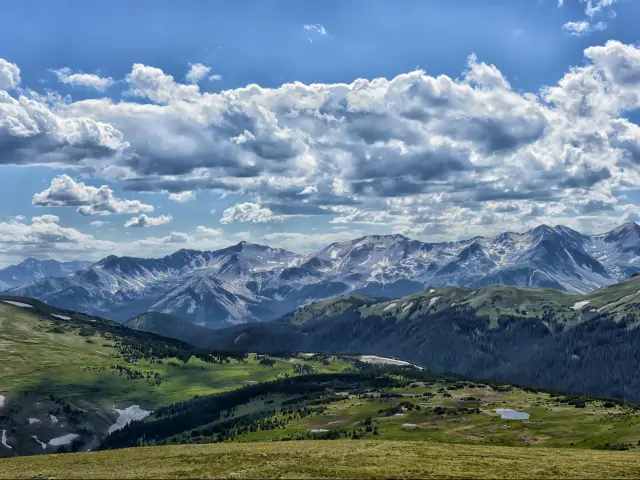
Located in Northern Colorado and spreading over more than 265,000 acres is the Rocky Mountain National Park!
You can get there by driving across Utah and into the Rockies along I-15 and I-70 or, if you prefer, a flight to Denver or one of the smaller local airports will get you a whole lot closer.
Initially inhabited by Paleo Indians and Native Americans, the park was explored by several European settlers and American travelers, particularly Enos Mils, who is known famously as the Father of the Rocky Mountain National Park.
Rocky Mountain National Park is one of the top destinations to spot wildlife and trek to find some of the prettiest lakes in the country (like Bear Lake, set at an altitude of nearly 10,000 ft.)
The park is also home to some very tall mountain peaks with the park's highest being Long's Peak at a staggering 14,259 ft above sea level.
The park is a hiker's dreamland, with 355 trails varying in altitude and difficulty so there's almost a hiking route for every day of the year.
You can go fishing, horseback riding, bird watching, or take a scenic drive along the iconic Trail Ridge Road for some stellar views of the Rockies.
Visiting in the late springtime or early summer is ideal for enjoying all the park offers although summers are not too hot and can be very pleasant given the altitude.
If you are visiting Rocky Mountain National Park, keep in mind that the national park uses a timed entry permit system. Please check the national park's website to see if you need to make a reservation before your visit.
24. Great Sand Dunes National Park, Colorado
12 hours from Las Vegas (700 miles)

If you're searching for a unique national park with mountains, forests, lakes and the tallest sand dunes in North America, then look no further than the Great San Dunes National Park in Colorado.
Located in Southern Colorado, about a 12-hour drive from Las Vegas, this region is known for its towering dunes, jagged mountain range, one-of-a-kind geology, etc.
There are 3 different routes that all take you there in around 12 hours of pure driving before accounting for stops - the I-15 and I-70 route through Utah or the two routes going north and south around the Grand Canyon, pas Monument Valley and through Pagosa Springs.
If you want to save time, Colorado Springs and Santa Fe are fairly close or you can catch a flight to one of the smaller local airports.
The sand dunes in the park constantly shift due to the wind, making every visit to the Great Sand Dunes National Park from Las Vegas unique.
The highest peaks of the sand dunes reach over 750 feet and are the centerpiece of the national park.
But there is a lot more than just the sand dunes to explore - you're in the foothills of the Rockies so you've got alpine lakes, vast wetlands, and even alpine tundra.
You can go sandboarding and sledding on the sand dunes, take a scenic drive on the Medano Pass Primitive Road, or have a go at fishing in the Sand Creek Lakes.
As an International Dark Sky Park, it's also the perfect place to camp and catch awe-inspiring views of the starry night.
The park's range of habitats means there's a vast range of wildlife - you'll find pronghorns (especially at sunrise), owls, bighorn sheep, elk, and the park is also home to a number of bears.
Great Sand Dunes National Park may be a a bit far from Las Vegas, but it's well worth the trip if you have a bit more time.
25. Crater Lake National Park, Oregon
12 hours from Las Vegas (730 miles)
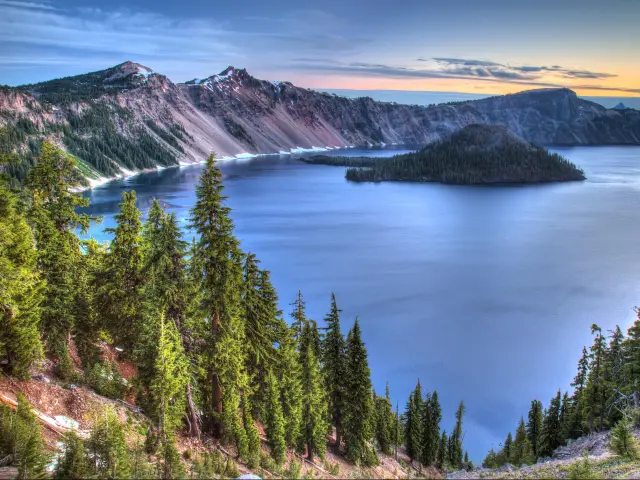
Known for its namesake Crater Lake and Mount Mazama, a now-collapsed volcano, Crater Lake National Park is a scenic area situated in the Cascade Mountain Range in southern Oregon.
And yes - you might be scratching your head how exactly you get to Oregon from Las Vegas, but you can get to the park in just 12 hours on the road - about the same amount of time as driving to the Rockies.
The route up to Crater Lake will take you across Nevada to Reno before crossing into California and continuing your drive along the Sierra Nevada past one National Forest after another until you reach Crater Lake National Park north of Klamath Falls.
A stunning national park, it has a lot of geological history that led to the distinctive landscapes that it houses today.
The collapse of Mount Mazama was caused by a volcanic eruption nearly 8,000 years ago and was witnessed by the Native Americans that inhabited the region.
During the summer months, you can go fishing, explore the meadows on a bicycle, and go on a boat tour through some of America's most pristine lakes. Crater Lake might be relatively small, but it is the deepest lake in the United States so there is a lot happening below the surface!
There are endless streams and waterfalls throughout the park that make for an amazing place to explore nature.
In springtime, the valleys come alive with beautiful wildflowers that you can explore as you hike the Castle Crest Wildflower Garden Trail.
The most frequently spotted wildlife in the area is elk and deer although black bears are also about, along with countless birds like owls, eagles, and hawks.
If you get super lucky, you might even catch a glimpse of a cougar. The are pretty shy, however, so you might blink, and it'll be gone.
Though located reasonably far from Vegas, the blend of an abandoned volcanic mountain and a breathtaking azure lake makes Crater Lake National Park an outstanding option for a trip!
If you are looking to visit some lakes closer to Las Vegas, check out our ultimate guide to the best lakes near Las Vegas.
READ MORE - Best Lakes Near Las Vegas
26. Guadalupe Mountains National Park, Texas
12 hours 40 minutes from Las Vegas (840 miles)
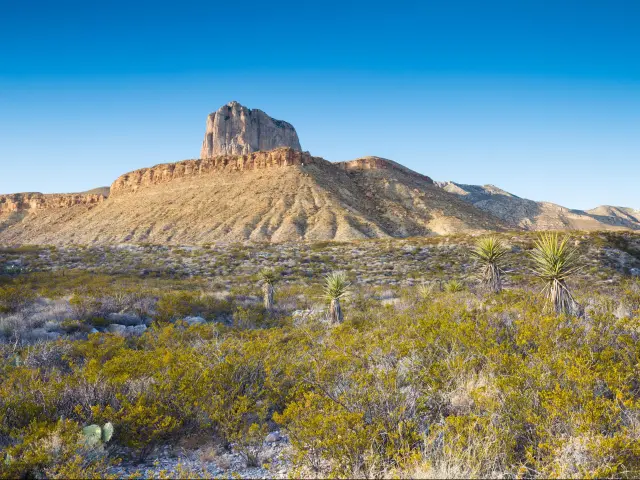
A hiker's paradise, the Guadalupe Mountains National Park is a vast, otherworldly landscape located in Western Texas, about a 13 hours drive from Las Vegas.
This is a bit of a trek as you can find national parks with deserts and national parks with mountains a lot closer to Vegas.
But if you want both of those in one amazing package, Guadalupe Mountains National Park is where you'll need to go.
To get to the park from Las Vegas, you'll need to follow US-93 all the way down to Phoenix, Arizona and then hop on the I-10 taking you through Tucson to Las Cruces and El Paso. From there, US-62 will take you right to the national park.
Home to a variety of different topography, Guadalupe Mountains is home to the tallest peak in Texas (called Guadalupe's Peak), which stands 8,751 feet tall, and the Permian fossil reef.
The park is frequently referred to as “America's best-kept secret” due to its vast desert-like arid appearance and the remote location that makes it seem hidden in plain sight.
The region has a rich and complex history, with the mountains having lived through environmental degradation for thousands of years.
The hills were inhabited up to 10,000 years ago, evidenced by art and relics in the caves and surrounding mountains.
More recently there were Indigenous and European settler settlements, but the area was ultimately declared a wilderness area in 1978 by the US Congress.
The park includes 1000 species of plants throughout the region, accompanied by lush green ponderosa pine and douglas fir forests.
You'll also be able to spot animals like mountain lions, mule deer, coyotes, bobcats, and maybe a couple of the 290 different species of birds that call the park home.
27. Carlsbad Caverns National Park, New Mexico
13 hours 15 minutes from Las Vegas (874 miles)
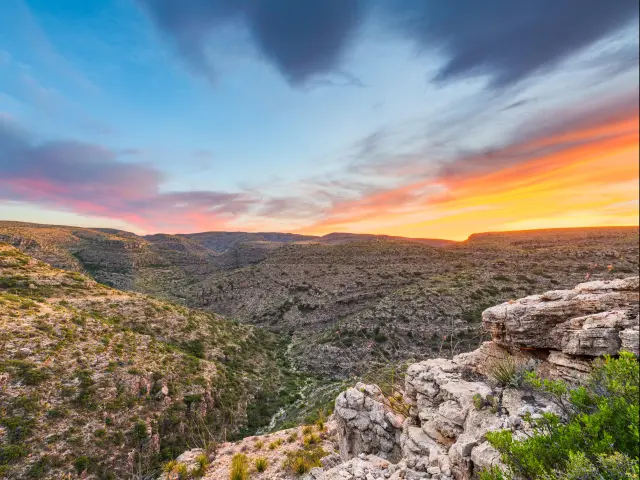
A national park like no other, the Carlsbad Caverns National Park is located in Southern New Mexico and is bound to wow you!
Though located nearly nine hundred miles from Vegas, the route to your destination certainly makes for a great road trip!
You can reach Carlsbad Caverns National Park from Vegas the same way as the route to Guadalupe Mountains above - via Phoenix, Tucson and El Paso. It's only 30 miles further up the road.
But a marginally quicker route is to follow the I-40 from Kingman all the way across Arizona, past Flagstaff and Albuquerque and then follow US-285 south to Carlsbad, New Mexico.
There's only about 15 to 20 minutes difference between the two routes, so you might want to come back a different way to mix things up although a flight to El Paso would save a lot of time if the road trip doesn't appeal!
Known for its arid desert landscape, deep historically-rich caves, wildlife, and rugged rocky canyons, the Carlsbad Caverns National Park is a distinctive region worth exploring.
The national park has nearly 120 caves, all of which were formed due to sulphuric acid dissolving limestone, making the caves indeed a sight to see.
You can participate in one of the many ranger programs hosted by the NPS in this park, like the Dawn of the Bats Program or Night Sky Programs, or go hiking and explore the caves (reservations are required, so plan ahead) and explore the exhibits at the visitor center!
The main sight in the park is the namesake cave, Carlsbad Cavern, which comprises the Big Room, a limestone chamber that is nearly 4,000 feet long, making it the third-largest chamber in North America.
Be sure to explore other places like the Three Rivers Petroglyph Site, Billy the Kind Museum, and more.
28. Redwood National Park, California
13 hours 40 minutes from Las Vegas (765 miles)
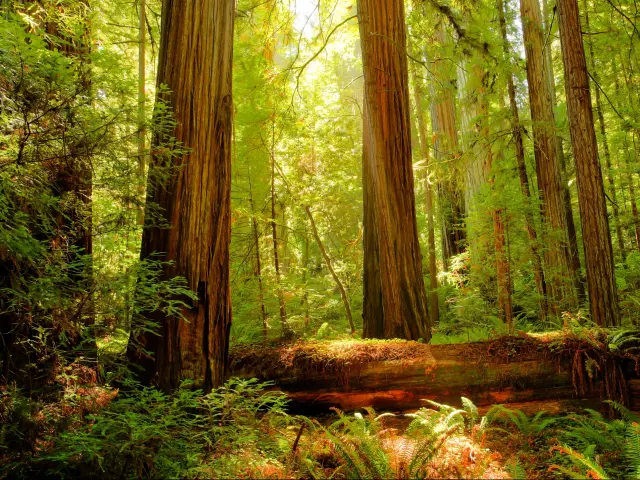
Home to the world's tallest trees, wild rivers, and up to 40 miles of rugged coastline, Redwood National park is located on the Northern California coast.
The easy route is 100 miles longer, but takes about the same amount of time because it's pure highway driving. Take the I-15 and Route 58 to Bakersfield, California and then hop onto the I-5 to San Francisco.
From San Francisco, US-101 will take you another 300 miles north until you reach the park. If you have time on your hands, you can follow Highway 1 along the coast, but that'll make the long road trip even longer.
The more direct route is only 765 miles long, going across Nevada to Reno and then cutting across Northern California approaching the park from the east. You save 100 miles, but it'll take you just as long to get there.
Redwood National Park is in an area with a number of nature preserves - Six Rivers National Forest, Marble Mountain Wilderness Area and the Prairie Creed Redwoods State Park are all nearby.
The ancient woodlands are home to the world's tallest trees with the redwood Hyperion being the tallest at 379 feet.
There are oak woodlands and around 200 miles of trails to explore in this World Heritage Site and International Biosphere Reserve.
The forest is home to Roosevelt elk roaming the grounds, and you might find salamanders in the river (on which you can go kayaking).
Redwood National Park might not be close to Las Vegas, but it might just be worth the long drive!
29. Mount Rainier National Park, Washington
16 hours from Las Vegas (1,050 miles)
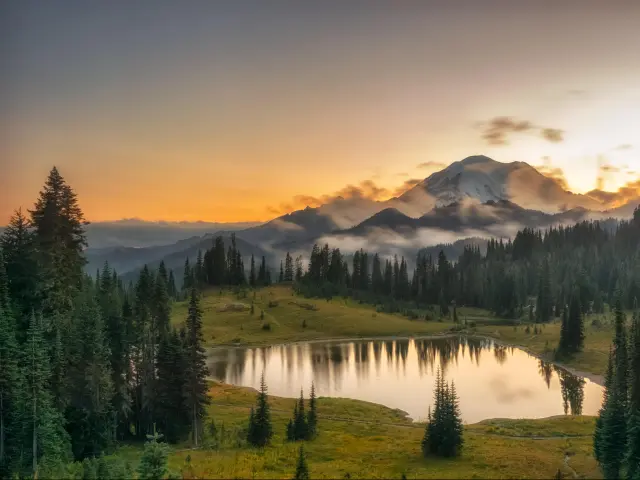
Spread across 236,000 acres in Washington State, the picturesque Mount Rainer National Park is the the place where you can see this huge mountain up close and the nature around it.
At 1,050 miles away Las Vegas, it'll take you a little while to get to Mount Rainier - two solid days of driving after you account for food and fuel stops.
The route is not the most exciting either. US-93 will take you right up the length of Nevada and into Twin Falls and you then have to drive a few hundred miles along the I-82 past Boise and Kennewick with Mount Rainier National Park coming shortly before you get to Seattle.
The park is known for the massive Mount Rainer (duh!) that stands high and mighty at 14,410 feet.
If you haven't done enough driving on the way, Sunrise Road goes up to 6,400 feet and offers amazing views of deserted volcanoes, wildflower valleys and old-growth forests.
The park's forest is broken up by stunning lakes like the Reflection Lake (one of the most photographed locations in the park) and Tipsoo lake (surrounded by wildflowers in late summer).
If you're a seasoned backpacker, the Wonderland Trail is a 93-mile loop that goes around Mount Rainer and although it's definitely not a quick one, you'll see the mountain from every angle there is!
Some adventure excursions like climbing Mount Rainer require an additional permit and fee on top of the entrance fee (at $30 per vehicle), so be sure to look into that while planning your road trip.
Mount Rainier National Park is open all year round, with each season yielding a different kind of beauty.
Visiting in the winter is perfect for a serene trip filled with plenty of snow adventure activities, while the fall is ideal for huckleberry picking and witnessing the red-hued trees.
No matter which month you end up visiting, the beautiful Mount Rainer National Park will leave you in awe.
Bonus: If you get lucky, you may spot the glorious black bears who emerge as the snow melts in the spring!
30. Big Bend National Park, Texas
16 hours 30 minutes from Las Vegas (1,060 miles)
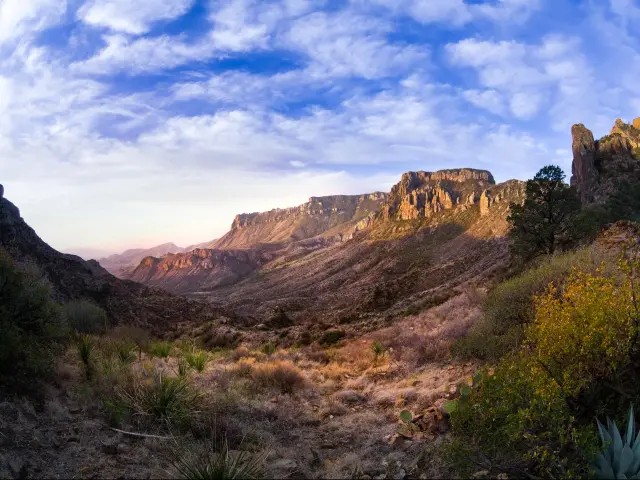
With 150 plus miles of mountain and desert hikes, Big Bend National Park is undoubtedly a must-visit spot for passionate hikers looking for the ultimate scenic overlooks.
The furthest national park from Las Vegas on our list is just over 1,000 miles away in southwest Texas.
Though it's a long road trip, the route has a lot of places to stop, including some of the other national parks mentioned - Saguaro, Petrified Forest, White Sands, Guadalupe Mountains, and Carsbad Caverns National Parks are all on the way!
The faster route from Las Vegas to Big Bend takes the I-10 through Phoenix, Tucson and El Paso but you can drive back further north along the I-40 through Albuquerque and Flagstaff if you want to take a different route back.
As the most extensive protected area of the Chihuahuan Desert, the park preserves 1,200 species of plants and many endemic animals and birds.
You can go on a scenic drive, take a river trip, soak in the park's beauty while horseback riding, camp in the park and stargaze, and... yes... hike!
The Ross Maxwell Scenic Drive is a popular option, boasting panoramic views of the Chisos mountain range and beyond.
Don't miss the Santa Elena Canyon, which has beautiful limestone cliffs, and Langford Hot Springs.
As a dry and low-humidity region, the weather in Big Bend National Park can become incredibly hot during the summer months.
Visiting in the spring or fall is ideal for making the most of your visit, while the summer is great for excursions on the Rio Grande River (bring your passport!).
Best National Monuments, State Parks, National Conservation Areas and Preserves
If you want to explore nature beyond the huge list of national parks above, there are other local places you can spend time in nature without crossing umpteen state lines.
1. Red Rock Canyon National Conservation Area, Nevada
20 minutes from Las Vegas (16 miles)

Located barely twenty minutes from Las Vegas is the Red Rock Canyon National Conservation Area, the first conversation area of Nevada!
Spread across 195,000 acres, Red Rock Canyon is an oasis of diverse landscapes and breathtaking rock formations.
Not only are they great to look at, but you can get a glimpse into the history of the area and its inhabitants by seeing ancient inscriptions and petroglyphs on your way around.
Red Rock canyon is a conservation area for unique wildlife and plants with 26 great hiking routes along barren red sandstone grounds just outside Vegas.
You can explore the park in your car following the scenic 13-mile drive where you'll be surrounded by the canyons or trek the Ice Box Canyon trail to discover seasonal waterfalls.
You might need to reserve a timed-entry slot ahead of your visit, check the official website for more information.
2. Tule Springs National Monument, Nevada
22 minutes from Las Vegas (18 miles)
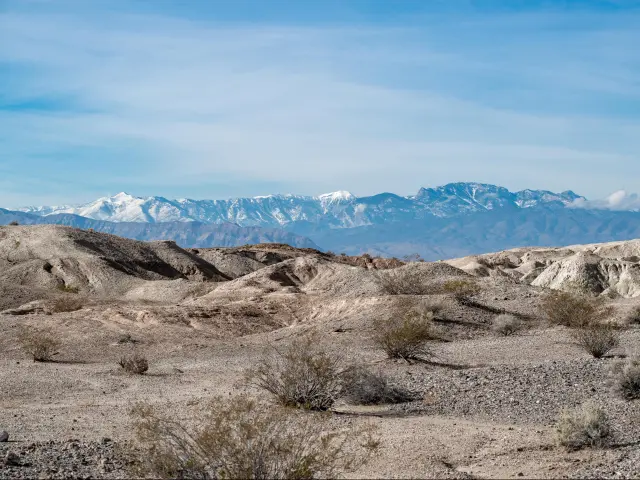
If you're searching for an exciting day out from the city, Tule Springs Fossil Beds National Monument, located on the outskirts of Las Vegas, is an excellent option!
It'll take you just 20 minutes to get there from central Las Vegas so this is an easy option even if you only have half a day to spare.
Administered and managed by the National Park Service, this 22,650-acre will give you a glimpse into the prehistoric world as it is home to fossils of now-extinct mammoths, lions, horses, bison, dire wolves, and more.
Commissioned as a National Monument with the hopes of increasing awareness and dedicating it to the study of the Ice Age, this is a paradise for anyone looking for an interactive learning experience that's sure to be enriching for all ages.
Besides the fossils, see if you can spot the scarce Las Vegas Bearpoppy flowers around the park!
3. Hoover Dam and Lake Mead National Recreational Area, Nevada
40 minutes from Las Vegas (37 miles)

Located less than an hour away from Las Vegas, still within Nevada, is the Lake Mead National Recreational Area.
A short drive on East Lake Mead Boulevard will get you to America's first and largest Recreation Area.
Here you'll get a chance to explore iconic mountains, rugged canyons, and two picturesque lakes (Lake Mead and Lake Mohave), where you'll be able to catch a vibrant sunset or relax by the water.
The famous Hoover Dam is a popular spot for grabbing a photo, but you can also go hiking, canoeing, swimming, backcountry camping, and even fishing or scuba diving if you want to!
Lake Mead National Recreational Area is close to Las Vegas and is known for its scenic trails, like the Historic Railroad Trail (home to several tunnels leading to the Hoover Dam), River Mountains Loop (a 34-mile trail connecting the area with the Las Vegas valley), and Liberty Bell Arch loop (which leads to a beautiful overlook of the Black Canyon).
READ MORE - Road Trip From Las Vegas To Hoover Dam and Lake Mead
4. Valley Of Fire State Park, Nevada
50 minutes from Las Vegas (46 miles)

Spread over 46,000 acres in Overton, Nevada, is one of the most famous state parks in the country - the Valley of Fire State Park, home to distinctive red sandstone formations that were formed nearly 150 million years ago as a result of shifting dunes.
This state park is located a 50-minute drive from Las Vegas and it is an incredible place for a day trip or as a stopover point on your way to national parks in Utah or Colorado.
You'll get a chance to learn more about the park's rich history (discover petroglyphs carved by Native Americans that inhabited the region), ecology, and geology at the visitor center, spend an afternoon picnic at one of the park's campsites and explore the many hikes that the park offers.
5. Mojave National Preserve, California
1 hour 5 minutes from Las Vegas (68 miles)
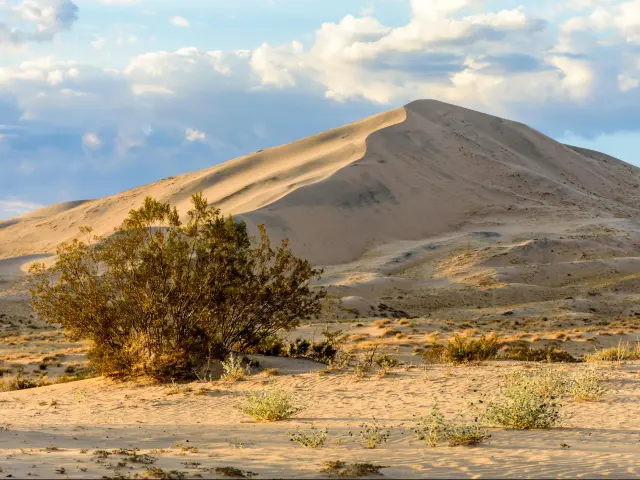
Located nearly 70 miles southwest from Las Vegas is the Mojave National Preserve.
It'll take you around an hour to get there and it's hard to miss - it's just off the I-15 headed as you cross into California.
The preserve is a haven for water-sculpted canyons, towering mountains, ancient volcanoes and peculiar sand dunes - the landscape is a lot more diverse than you might think.
After a short visit to the Kelso Depot visitor center, located in a Spanish Mission Revival style 1924 railroad station to pick up maps and memorabilia, you can head out to explore the Kelso Dunes famous for making "singing sounds".
You can also explore the Cima volcanic field, a Joshua tree covered area with dozens of volcanic cones and lava flows.
Although the area is arid and desolate, there is some wildlife about - if you're lucky, you could spot mountain lions, bats, bighorn sheep, coyotes, and even owls that call the preserve their home.
6. Cedar Breaks National Monument, Utah
3 hours 15 minutes from Las Vegas (205 miles)
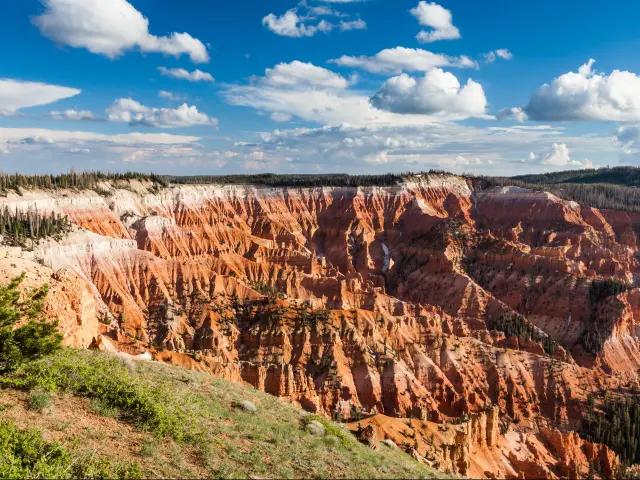
The vast, orange-hued Cedar Breaks National Monument is located in the lush green Dixie National Forest near Zion and Bryce Canyon National Parks.
It's a great day out if you're searching for a 3-hour long road trip from Las Vegas with incredible views or something to add to your itinerary visiting other Utah national parks.
Cedar Breaks National Monument is a natural amphitheater that spans over 3 miles with a depth of 2,000 feet offering an absolutely stunning view.
The rim of the cliff is at an elevation of 10,000 feet above sea level, making it feel like you can just catch the starry night sky in your hands!
It's an all-weather national monument but remember that if you decide to go in the winter, it can be bitterly cold and you can even go skiing and snowmobiling.
7. Vermilion Cliffs National Monument, Arizona
3 hours 50 minutes from Las Vegas (235 miles)
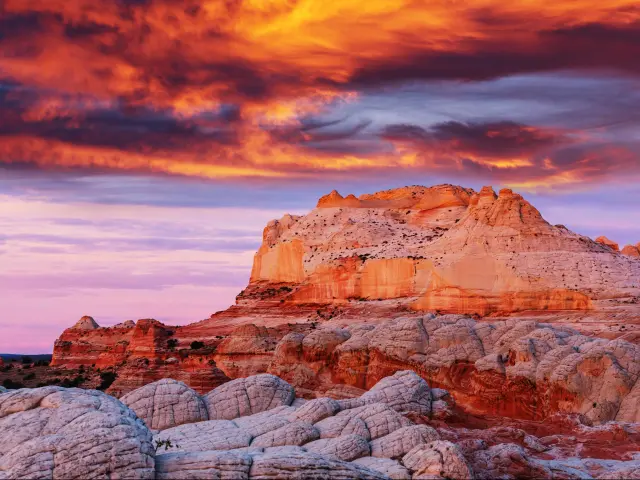
One of the most colorful collections of rugged sandstone canyons, the Vermilion Cliffs National Monument is located about a four-hour drive from Las Vegas and is the perfect place for a short trip to a scenic and historically rich region!
Although they are worth visiting in their own right, it is a perfect stop point on the way to the north rim of the Grand Canyon National Park from Vegas.
The national monument covers 294,000 acres and is one of the most photographed spots is Coyote Buttes which are home to some of the most breathtaking sandstone cliffs in the world.
The hike to get there can be pretty challenging, and only a limited number of people can go on it per day (which is determined via a lottery system daily) so make sure you plan ahead to avoid getting turned away.
The area's rich history is shown off with plenty of petroglyphs, carvings, and claimed dinosaur footprints.
8. Glen Canyon National Recreational Area, Utah
4 hours 5 minutes from Las Vegas (260 miles)

Spread over an expansive 1.5 million acres, the Glen Canyon National Recreational Area in Utah is a wilderness like you have never seen and might just be the most remote part of the United States.
Located north of the Grand Canyon national park, Glen Canyon is the less known but incredibly spectacular cousin and you can reach it by heading towards Grand Canyon's North Rim and starting in Page or driving the long way around Navajo Mountain.
Just remember - this area is vast so distances on the map can be deceiving!
There are many unique things to do in the area, like exploring the Colorado River by taking a Lees Ferry or hiking 1.5 miles to the overlook of the iconic horseshoe bend in the river engulfed by the rugged red canyons.
You can spend as long as you like exploring Glen Canyon with all the usual land and water based activities on offer and at around 4 hours from Las Vegas you could make it into a weekend getaway.
9. Antelope Canyon, Arizona
4 hours 30 minutes from Las Vegas (280 miles)

Known globally as the most famous slot canyon formation, it's one of the must-visit bucket list items for people around the world and just happens to be relatively close to Las Vegas in Navajo, close to Page, Arizona.
The route from Las Vegas takes you north of the Grand Canyon and Antelope Canyon is very close to the Vermilion Cliffs National Monument and the famous Horseshoe Bend in the Colorado river.
In fact, if you are coming this far, it makes sense to combine a few of these sights together.
The Antelope Canyon area includes five distinct slot canyons, namely Upper Antelope Canyon, Lower Antelope Canyon, Owl Canyon, Mountain Sheep Canyon, and Rattle Snake Canyon, each with its own unique views and hikes.
It's important to note that you can't just go and visit the canyon slots independently as all visits have to be booked through licensed tour operators.
Besides taking in the picturesque coral-colored canyons, you'll also be able to explore the sights in Buckskin Gulch, White Pocket, and other scenic vistas within the broader Vermilion Cliffs space.
10. Monument Valley, Arizona - Utah border
6 hours 20 minutes from Las Vegas (325 miles)
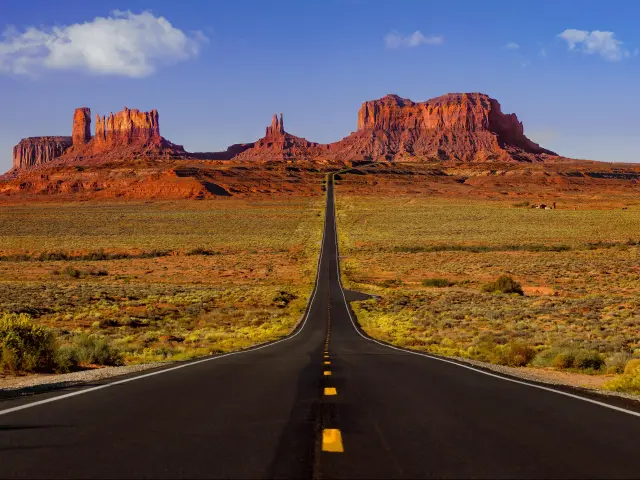
Located on the border of Arizona and Utah, Oljato-Monument Valley is a Navajo Tribal Park that is world famous for it staggeringly beautiful rocks towering above the desert.
This area is known as Tsé Bii' Ndzisgaii to the Navajo Tribe on whose land it is located.
The park is located at 5m 500 feet above sea level and was made famous as a backdrop to Western movies with the giant monoliths standing tall above the flat desert below.
It will take you over 6 hours on the road before accounting for stops to get here, but the views more than make up for the long drive as it's one of the most surreal places you'll ever see.
It costs $10 for ages nine and up for you to go and admire the views, partake in the rugged valley's hikes, and camp in the remote location for an off-beta trip like no other!

